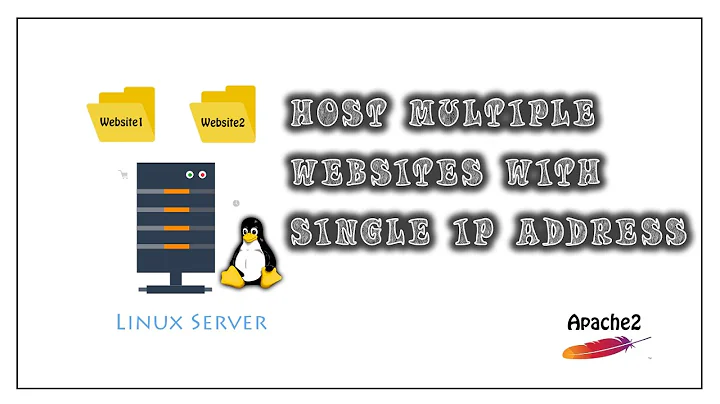Hosting multiple domains on a single email server with one IP
Solution 1
Both approaches are valid, do know that this record will not show as the originating address. When you send an email to one of your configured addresses, the sending MTA will look up the MX record configured for your domain. It will get the IP from that domain and it will open an SMTP session with your SMTP server (or one of your SMTP servers if you have configured more than one).
Even without an MX record it will work, because then the MTA just looks up the A record for your domain. (providing your A record points to your SMTP server of course)
Solution 2
Both approaches are perfectly valid. Approach 1 is probably better if you would like to use TLS later on.
By the way, the mail exchanger record doesn't show where mails originate but where they will be sent to.
Related videos on Youtube
Mohamed Mohamed
Updated on September 18, 2022Comments
-
 Mohamed Mohamed over 1 year
Mohamed Mohamed over 1 yearI have an email server (mail) that currently hosts one domain example1.com. The server is behind NAT and I have split-dns configured on the LAN.
The time has come to host additional domains on the same email server and after many hours of googling I have read conflicting information on how to create the public (external) and internal DNS records. There seems to be two approaches to configuring the MX and A records which I will demonstrate below.
APPROACH 1
External DNS for example1.com
example1.com 7200 MX 10 mail.example1.com. mail.example1.com 3600 A 213.xx.xx.xxExternal DNS for example2.com
example2.com 7200 MX 10 mail.example1.com. mail.example1.com 3600 A 213.xx.xx.xxIn the first approach the MX record for example2.com points to the first domain, e.g. example1.com.
This seems to be how email hosting companies like Google Apps and ISPs work.
The problem with this method for my situation is that I don't want emails from example2.com to show that they originate from example1.com. The "solution" to this would be that I purchase a third domain let's say mail.myemailserver.com which would be used as the default (or first) domain for the email server.
APPROACH 2
External DNS for example1.com
example1.com 7200 MX 10 mail.example1.com. mail.example1.com 3600 A 213.xx.xx.xxExternal DNS for example2.com
example2.com 7200 MX 10 mail.example2.com. mail.example2.com 3600 A 213.xx.xx.xxIn the second approach the MX record for the second domain points to its own domain, e.g. example2.com.
What I'm asking for is have I understood the configuration of multiple domains hosted on a single server and is there a best practice or advice on which approach I should implement in my own environment.
-
dikkini about 5 yearsIn APPROACH 1, External DNS for example2.com,
mail.example1.com 3600 A 213.xx.xx.xx- there is an error and instead ofmail.example1.comshould bemail.example2.comor there is specific case?
-
-
 Mohamed Mohamed about 12 yearsYou mentioned TLS. Are you referring to webmail via SSL? If so then yes that is already configured for the first domain. Regarding the origin of the mail won't the headers contain example1.com if I use approach 1?
Mohamed Mohamed about 12 yearsYou mentioned TLS. Are you referring to webmail via SSL? If so then yes that is already configured for the first domain. Regarding the origin of the mail won't the headers contain example1.com if I use approach 1? -
 Mohamed Mohamed about 12 yearsthanks for your explanation. Are there any advantages or disadvantages of either approach?
Mohamed Mohamed about 12 yearsthanks for your explanation. Are there any advantages or disadvantages of either approach? -
 Lucas Kauffman about 12 yearsWell the better approach is to use an MX record, the reason for this is that it might be you want to split your mail server from your webserver for example. Then you can configure MX records for multiple mail servers while your A record still points at the correct webserver.
Lucas Kauffman about 12 yearsWell the better approach is to use an MX record, the reason for this is that it might be you want to split your mail server from your webserver for example. Then you can configure MX records for multiple mail servers while your A record still points at the correct webserver. -
 Lucas Kauffman about 12 years@yonatan No, the received header only contains mailservers that are passed, the content is their IP and the reverse dns of that IP, not the MX record.
Lucas Kauffman about 12 years@yonatan No, the received header only contains mailservers that are passed, the content is their IP and the reverse dns of that IP, not the MX record. -
 Mohamed Mohamed about 12 yearsJust so I've understood when you say "an MX record" you are referring to approach 1, right? ;)
Mohamed Mohamed about 12 yearsJust so I've understood when you say "an MX record" you are referring to approach 1, right? ;) -
 Oliver about 12 yearsNo, I'm referring to encrypted SMTP. I'm not sure if this is a problem, but when you use this, you typically have one certificate installed (e.g. containing the common name mail.example1.com). If a server connects to mail.example2.com and is presented with the certificate mail.example1.com, this might cause a problem. As for the mail headers: at some point you will certainly have a mention of example1.com in the headers, no matter how you do it. Why waste your time to work around this?
Oliver about 12 yearsNo, I'm referring to encrypted SMTP. I'm not sure if this is a problem, but when you use this, you typically have one certificate installed (e.g. containing the common name mail.example1.com). If a server connects to mail.example2.com and is presented with the certificate mail.example1.com, this might cause a problem. As for the mail headers: at some point you will certainly have a mention of example1.com in the headers, no matter how you do it. Why waste your time to work around this? -
 Lucas Kauffman about 12 yearsActually to both approaches :p. An MX record is configured to point to a mailserver for a domain. In the end it just goes looking for an IP and connects to that IP, it doesn't care about what MX record is configured as long as the A record that goes with the MX record (so mail.example1.com and mail.example2.com ) point to an IP.
Lucas Kauffman about 12 yearsActually to both approaches :p. An MX record is configured to point to a mailserver for a domain. In the end it just goes looking for an IP and connects to that IP, it doesn't care about what MX record is configured as long as the A record that goes with the MX record (so mail.example1.com and mail.example2.com ) point to an IP. -
 Mohamed Mohamed about 12 years@oliver the two domains are for two independent companies that's why I want it to look as if the domains are hosted on two separate email servers even though they are not.
Mohamed Mohamed about 12 years@oliver the two domains are for two independent companies that's why I want it to look as if the domains are hosted on two separate email servers even though they are not. -
 Mohamed Mohamed about 12 yearsCool I understand. One final thing. I might have overlooked this in my question, but for approach 2 I would need to add a new zone for example2.com, yes (not necessary in approach 1)?
Mohamed Mohamed about 12 yearsCool I understand. One final thing. I might have overlooked this in my question, but for approach 2 I would need to add a new zone for example2.com, yes (not necessary in approach 1)? -
 Oliver about 12 yearsIf this is an absolute must for you, you should go with approach 2 then. As said, this is perfectly valid.
Oliver about 12 yearsIf this is an absolute must for you, you should go with approach 2 then. As said, this is perfectly valid. -
 Lucas Kauffman about 12 yearsYou would need to do that anyway because you have 2 different domains to manage. Every domain has its own zonefile. Since example2 is also present in approach 1, you would still need to add a zonefile for it.
Lucas Kauffman about 12 yearsYou would need to do that anyway because you have 2 different domains to manage. Every domain has its own zonefile. Since example2 is also present in approach 1, you would still need to add a zonefile for it. -
 Mohamed Mohamed about 12 yearssorry I should have explicitly said add a new zone to the internal DNS, e.g. "for approach 2 I would need to add a new zone internal DNS for example2.com, yes (not necessary in approach 1)?
Mohamed Mohamed about 12 yearssorry I should have explicitly said add a new zone to the internal DNS, e.g. "for approach 2 I would need to add a new zone internal DNS for example2.com, yes (not necessary in approach 1)? -
 Lucas Kauffman about 12 yearsof course, it works the same, it doesn't matter if it's internal or external, the protocol stays the same :)
Lucas Kauffman about 12 yearsof course, it works the same, it doesn't matter if it's internal or external, the protocol stays the same :) -
 Mohamed Mohamed about 12 yearsI'm very grateful for you patience and help! I'll try to setup the second domain tomorrow. Thanks again.
Mohamed Mohamed about 12 yearsI'm very grateful for you patience and help! I'll try to setup the second domain tomorrow. Thanks again. -
 Lucas Kauffman about 12 yearsGlad to help :)
Lucas Kauffman about 12 yearsGlad to help :)

![Hosting Multiple Sites in a single Web Server by Domain Names on Windows Server 2019 [WEB SERVER 03]](https://i.ytimg.com/vi/8ePwptikjyI/hq720.jpg?sqp=-oaymwEcCNAFEJQDSFXyq4qpAw4IARUAAIhCGAFwAcABBg==&rs=AOn4CLDAvOAsVKdWrMe-PgCLLM2nECa1_g)


